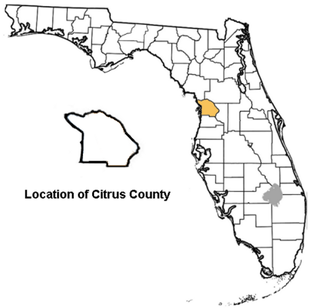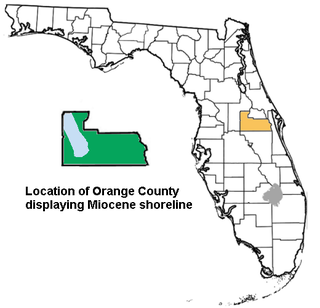


The Polk County paleontological sites are assemblages of Early Miocene to Late Pleistocene vertebrates occurring in Polk County, Florida, United States.



The Polk County paleontological sites are assemblages of Early Miocene to Late Pleistocene vertebrates occurring in Polk County, Florida, United States.
Era : Neogene
Period : Miocene to Pleistocene, ~17.7—1.5 Mya. (calculates to a period of approximately 16.2 million years).
Faunal stage : Hemingfordian through early Clarendonian
Geological Formation : Bone Valley Formation.
Polk County can boast more individual fossil recovery sites than any other Florida county due to the phosphate mining concerns. Bone Valley Formation is a prime geologic formation. Some of these sites are: Agricola Road (AEO), [1] Agrico Pierce Mine (AEO), American Agricultural Chemical Company Mine, Brewster Phosphate Mine, Fort Meade Mine, [2] Kingsford Mine, Phosphoria Mine, Fort Green Mine, Payne Creek Mine, and Palmetto Mine.
Coordinates: 27°54′N81°48′W / 27.9°N 81.8°W

The taxa listed within this article were compiled from numerous collections within Paleobiology Database . authorized by John Alroy, Ph.D. Further documentation on these genera and species are available.

Mammalia is a class of animal within the phylum Chordata. Mammal classification has been through several iterations since Carl Linnaeus initially defined the class. No classification system is universally accepted; McKenna & Bell (1997) and Wilson & Reader (2005) provide useful recent compendiums. Many earlier ideas from Linnaeus et al. have been completely abandoned by modern taxonomists, among these are the idea that bats are related to birds or that humans represent a group outside of other living things. Competing ideas about the relationships of mammal orders do persist and are currently in development. Most significantly in recent years, cladistic thinking has led to an effort to ensure that all taxonomic designations represent monophyletic groups. The field has also seen a recent surge in interest and modification due to the results of molecular phylogenetics.
Handbook of the Mammals of the World (HMW) is a book series from the publisher Lynx Edicions. The nine volumes were published from 2009 to 2019. Each mammal family is assessed in a full text introduction with photographs and each species has a text account with a distribution map and illustrations on a plate. This is the second major project by Lynx Edicions since the release of the Handbook of the Birds of the World in 1992. The chief editors are Russell Mittermeier and Don E. Wilson in association with Conservation International, the Texas A&M University and the IUCN. Don E. Wilson is also editor of the reference work Mammal Species of the World.

The Torreya Formation is a Miocene geologic formation with an outcrop in North Florida. It is within the Hawthorn Group.

The Inglis quarry or Inglis quarry sites 1A and 1C are assemblages of vertebrate fossils dating from the Pleistocene ~1.8 Mya—300,000 years ago, located in the phosphate quarries near the town of Inglis, Citrus County, northern Florida.

The Haile Quarry or Haile sites are an Early Miocene and Pleistocene assemblage of vertebrate fossils located in the Haile quarries, Alachua County, northern Florida. The assemblage was discovered during phosphate mining, which began in the late 1940s. Haile sites are found in the Alachua Formation. Two sites within the Ocala Limestone yielded Upper Eocene Valvatida and mollusks.

The Orange County paleontological sites are assemblages of Late Pleistocene vertebrates occurring in Orange County, Florida.

The Hawthorn Group is a stratigraphic unit of Miocene age in South Carolina, Georgia, and Florida, in the United States. It is known for its phosphate rock resources, and for its rich assemblages of Neogene vertebrate fossils.